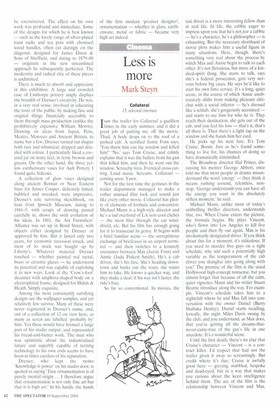Less is more
Mark Steyn
Collateral 15, selected cinemas
Isaw the trailer for Collateral a gazillion times in the early summer, and it did a great job of putting me off the movie. Thud. A body drops on to the roof of a parked cab. A terrified Jamie Foxx says, 'You threw him out the window and killed him!' No,' says Tom Cruise, and calmly explains that it was the bullets from his gun that killed him, and then he went out the window. Screechy tires. Frenzied cross-cutting. Loud music, Screams. Collateral — coming soon. Yawn.
Not for the first time the geniuses in the trailer department managed to make a rather unusual film look and sound just like every other movie. Collateral has plenty of elements of formula and convention: Michael Mann is a high-style director and he's a tad overfond of LA noir-cool clichés — the neon blur through the car windshield, etc. But his film has enough going for it to transcend its genre. It begins with a brief familiar scene — the surreptitious exchange of briefcases in an airport terminal — and then switches to a leisurely encounter between Max (Jamie Foxx) and Annie (Jada Pinkett Smith). He's a cab driver, she's his fare. She's heading downtown and barks out the route she wants him to take. He knows a quicker way, and they make a deal: if his way isn't faster, the ride's free.
So far so conventional. In movies, the taxi driver is a more interesting fellow than in real life. In life, the cabbie eager to impress upon you that he's not just a cabbie — he's a character, he's a philosopher — is exhausting. But the necessary shorthand of movie plots makes him a useful figure in many situations. Here, though, there's something very real about the process by which Max and Annie begin to talk to each other. It's not flirtatious, but more of a kindred-spirit thing. She starts to talk, says she's a federal prosecutor, gets very nervous before big cases. He says he'd like to start his own limo service. It's a long, quiet scene, in the course of which Annie unobtrusively shifts from making pleasant chitchat with a social inferior — he's dressed like a schlub, she's gorgeously accoutred — and starts to see him for who he is. They reach their destination, she gets out of the cab, and you feel his loss — that's it, that's all there is. Then there's a light tap on the window and she hands him her card.
He picks up his next fare. It's Tom Cruise. Boom. Just as he's found something to live for, his chances of doing so have dramatically diminished.
The Broadway director Hal Prince, discussing his mentor George Abbott, once told me that most people in drama misunderstand the word `energy' — they think it means rushing around, relentless, nonstop. 'George understands you can have all the energy you want in the absolutely stillest moment.' he said.
Michael Mann, unlike most of today's unthrilling thriller directors, understands that, too. When Cruise enters the picture, the formula begins. He plays Vincent, who's flown into Los Angeles to kill five people and then fly out again. Max is his involuntarily designated driver. If you think about this for a moment, it's ridiculous. If you need to murder five guys on a tight schedule, why add such a potentially high variable as the temperament of the cab driver you shanghai into going along with you? The premise of the film is the usual Hollywood high-concept nonsense, but you almost forget that because of all the calm, quiet vignettes Mann and his writer Stuart Beattie introduce along the way. For example, Vincent's schedule takes him to a nightclub where he and Max fall into conversation with the owner Daniel (Barry Shabaka Henley). Daniel starts recalling, lyrically, the night Miles Davis swung by the club, and you understand, as Max does, that you're getting all the dreams-thatnever-came-true of the guy's life in one anecdote. Ifs a wonderful scene.
Until the first death, there's no clue that Cruise's character — Vincent – is a contract killer. I'd respect that had not the trailer given it away so screamingly. But credit where it's due: Cruise is awfully good here — greying, stubbled, bespoke and dead-eyed, but in a way that makes you curious about the keen intelligence behind them. The arc of the film is the relationship between Vincent and Max. The killer warms up to the cabbie, and the cabbie is forced to learn from the killer, too — that there are times when you have to move, act, make the running.
Vincent uses his wardrobe to communicate his physical power. He wears those figure-hugging inch-too-short pants Gene Kelly always wore, and they set my mind wandering back to Singin' in the Rain. One reason why that's Kelly's best movie is because the writers Comden and Green traded off his limitations as an actor — the insincerity, the cheesy smile — and created a plot about a very limited actor with an insincere cheesy smile. Consciously or not, something similar is at work here: Cruise has been a movie star for almost two decades, physically perfect to an almost narcissistic degree but somehow rather boring and empty. So Mann and Beattie make Vincent an empty vessel — cold, hollow, a man with no past, no biography, a man whose existence is expressed through his physique and through action. A beautiful nihilist, Vincent is a role in which Cruise's limitations become virtues. The character is little more than a stunt. but Cruise turns in one of his best performances in years.
The end? Oh, dear. Big chase. Subway trains. There've been far too many of those this summer. But, if the final destination's a bit of a disappointment, getting there is a lot of fun.



















































































 Previous page
Previous page